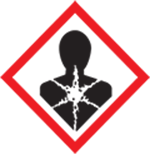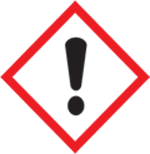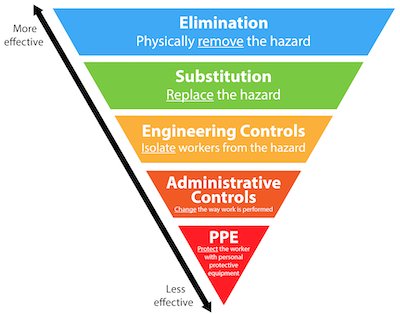Methylene Chloride
This chemical standard operating procedure (SOP) and the associated Safety Data Sheet (SDS) are for our safety. Read and understand both documents. If this is a paper copy, check for updated versions on the IsoLab website.
Process
Methylene chloride is used as part of the rock preparation procedure to clean polar organics from rock samples.
Hazards - SDS


Causes skin irritation. Causes serious eye irritation. May cause drowsiness or dizziness. Suspected of causing cancer.
Protection - SDS

Engineering Controls
Methylene chloride is to be used in one of the fume hoods in the 302 / 303 suite. Ensure the fume hood has proper air flow by checking the flow rate on the control panel and / or using a smoke match or wipe to visualize flow.
PHS - While the preferred fume hood is directly above the storage cabinet, any fume hood in the IsoLab suite is sufficient.
Administrative Controls
PHS - No specific administrative controls are required.
Personal Protective Equipment (PPE)
Wear a laboratory coat, eye protection, and Silver Shield gloves while working with methylene chloride.
PHS - Nitrile gloves DO NOT provide protection against methylene chloride. Wear Silver Shield gloves. These are located in 302B.
Handling - SDS
Keep container tightly closed when not in use.
PHS - Decontamination - Pour residual liquid into waste container. Wash glassware as per our cleaning laboratory glassware SOP.
Storage - SDS
Methylene chloride is stored in the flammables cabinet under the fume hood in 302B. Use MyChem, the UW EH&S chemical inventory database, for more lab-suite specific storage details.
Spills - SDS
Outside Fume Hood Spill - FUMES - Wear respiratory protection. Avoid breathing vapors, mist or gas. Ensure adequate ventilation. Remove all sources of ignition. Evacuate personnel to safe areas. Beware of vapors accumulating to form explosive concentrations. Vapors can accumulate in low areas.
PHS - Exposure:
- Inhalation - If breathed in, move person into fresh air. If not breathing, give artificial respiration. For advice, call UW Employee Health Center (206.685.1026) or the Washington Poison Center (800.222.1222). For emergency help, call 911.
- Skin contact - Wash off with soap and plenty of water. For advice, call UW Employee Health Center (206.685.1026) or the Washington Poison Center (800.222.1222). For emergency help, call 911.
- Eye contact - Rinse thoroughly with plenty of water for at least 15 minutes. For advice, call UW Employee Health Center (206.685.1026) or the Washington Poison Center (800.222.1222). For emergency help, call 911.
Inside Fume Hood Spill - The fume hood should protect you from fumes. Contain the solution with absorbent materials from the spill kit and place in a suitable waste container.
If you need assistance or advice, use the IsoLab Emergency Contacts sheet.
Consult the EH&S Spill Poster and Exposure Poster
Waste - SDS
If you are cleaning up after a spill and have a bag of debris, ensure the bag is sealed and use multiple bags as needed. Complete an EH&S Hazardous Waste Label and adhere it to the bag. Here are instructions for how to label chemical waste containers. Labels are located in a drawer on the west wall of 303B near the door to the hallway.
Put all waste, solid or liquid, into a glass container. Options for waste containers can be found under the west sink in 303B. Complete an EH&S Hazardous Waste Label and adhere it to the bottle. Here are instructions for how to label chemical waste containers. Labels are located in a drawer on the west wall of 303B near the door to the hallway.
Place the properly labeled container in one of the gray tubs near the hallway door of 303B. Segregate from other waste containers as appropriate.
Consult our generalized Chemical Waste Disposal SOP.

Training - PHS
Methylene chloride is deemed a particularly hazardous substance - PHS by EH&S and you need approval before using it. Complete the list of requirements below before using this chemical.
Prerequisites
- You must have completed Managing Laboratory Chemicals in the last three years. Login to check.
- Read and understand the SDS for Methylene chloride.
- Read, understand, and digitally sign this SOP.
- Contact your Principal Investigator (PI) AND the Chemical Hygiene Officer (CHO) indicating that you have completed all prerequisites and await approval.
